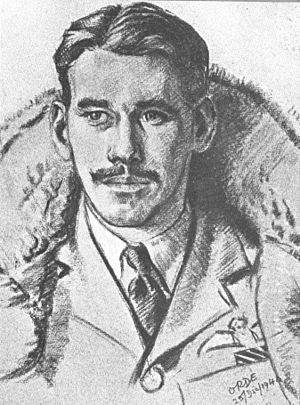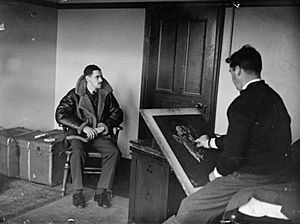John Mungo-Park facts for kids
Quick facts for kids
John Colin Mungo-Park
|
|
|---|---|

John Mungo-Park drawn by Cuthbert Orde (1940)
|
|
| Born | 25 March 1918 Wallasey, England |
| Died | 27 June 1941 (aged 23) Adinkerke, Belgium |
| Buried |
Adinkerke Military Cemetery
|
| Allegiance | United Kingdom |
| Service/ |
Royal Air Force |
| Years of service | 1937–1941 |
| Rank | Squadron Leader |
| Service number | 40008 |
| Commands held | No. 74 Squadron RAF |
| Battles/wars | Second World War |
| Awards | Distinguished Flying Cross & Bar |
John Colin Mungo-Park (born March 25, 1918 – died June 27, 1941) was a very brave pilot. He flew for the Royal Air Force (RAF) during World War II. He was known as a "flying ace." This means he shot down many enemy planes. He earned the Distinguished Flying Cross (DFC) in 1940. He also received a special "Bar" to his medal in 1941. This Bar showed he had earned the DFC again.
Contents
Early Life and Flying Dreams
John Colin Park was born on March 25, 1918. His hometown was Wallasey, in England. He was the third child in his family.
His father, Colin, joined the British Army in World War I. Sadly, his father was killed in action in 1918. John was only seven months old at the time.
John went to Liverpool College, a boarding school. He was a great athlete there. He started using the name Mungo-Park in school. "Mungo" was a family name for many years.
In 1934, his family moved to Bolton. A neighbor there loved flying planes. John and the neighbor became good friends. This is where John's love for flying began.
Joining the Royal Air Force
John Mungo-Park joined the Royal Air Force in June 1937. He quickly became a pilot officer. In 1938, he flew planes for the Fleet Air Arm.
When World War II started in September 1939, Mungo-Park moved to No. 74 Squadron RAF. He flew fast Spitfire planes. His commander was a famous pilot named Sailor Malan.
Helping at Dunkirk
In May 1940, his squadron helped protect British soldiers. These soldiers were leaving France during the Dunkirk evacuation. Mungo-Park was hurt during a fight. His Spitfire was also damaged. But he bravely flew it back across the English Channel. He landed safely at RAF Rochford.
Battles in the Sky
On July 10, his squadron fought many German planes. Mungo-Park shot down a Dornier bomber. He watched it "dive into the sea."
On August 11, he fought in four big air battles. He shot down one Bf 109 plane. He also damaged another. Later that day, he attacked two Bf 110 planes. He saw one crash into the sea. The other went down with black smoke. He was given credit for one destroyed and one "probable" victory. He scored another victory that day. He shot down a Bf 109 that burst into flames.
On August 13, his squadron fought more Dornier bombers. Mungo-Park shot down another one.
Earning the Distinguished Flying Cross
On October 20, he shot down another Bf 109. It crashed in Kent, England.
He was awarded the Distinguished Flying Cross (DFC) on November 15, 1940. This medal was for his bravery. The award said he had destroyed eight enemy aircraft. It praised his "great courage and coolness."
Mungo-Park became known as one of the best Allied pilots. He was one of "The Few." These were the brave pilots who fought in the Battle of Britain. His portrait was drawn by a famous artist, Cuthbert Orde.
On November 14, 1940, his squadron shot down 13 Ju 87 planes. Mungo-Park personally shot down two of them.
On November 30, he and another pilot shared a victory. They shot down a Bf 109. This was the 600th victory for squadrons flying from RAF Biggin Hill.
On December 31, 1940, he was promoted to flight lieutenant.
Squadron Leader and Final Mission
On March 10, 1941, Sailor Malan was promoted. Mungo-Park then became the acting Squadron Leader. This meant he was in charge of his squadron.
On June 16, 1941, he shot down two more Bf 109s. His own plane was damaged. But he managed to glide his Spitfire back to RAF Hawkinge. This showed great skill! For his bravery and leadership, he was told he would get a "Bar" to his DFC medal.
On June 27, 1941, Mungo-Park was flying his Spitfire. He was helping protect bombers over France. German Bf 109s attacked them. He was shot down and killed. His plane crashed near Dunkirk, in Belgium. He is buried in Adinkerke Military Cemetery.
A Bar to Mungo-Park's DFC was announced after his death. It was given on July 11, 1941. The award said he had destroyed at least twelve enemy aircraft. It also mentioned his skillful landing after his plane was damaged.
Mungo-Park was credited with destroying 11 enemy planes. He also helped destroy 2 others. He probably destroyed 5 more, and damaged 4.
Remembering a Hero
People have worked to remember John Mungo-Park. A Belgian man named Johny Recour saw Mungo-Park's plane crash as a boy. Thanks to him, a memorial service was held in 2006.
Several roads are named after John Mungo-Park. These include Mungo Park Way in Orpington, Mungo Park Road in South Hornchurch, and Mungo Park Close in Bushey. Other roads nearby are also named after Battle of Britain pilots.


